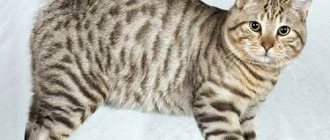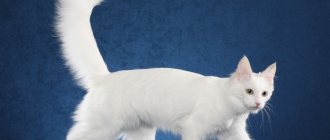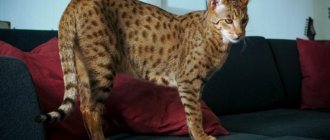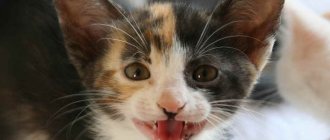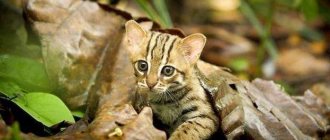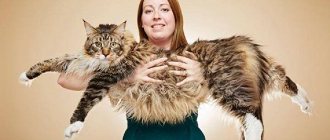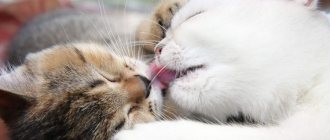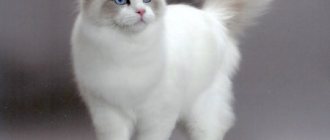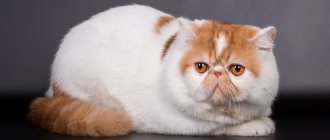History of the origin of the breed
Many of the stories indicate that the first representatives appeared around the 40s of the last century. It was at this time that a British breeder was transporting Abyssinian kittens to New Zealand, North America and Australia.
This was not a planned breeding. The ancestors of the Somalis are the short-haired Abyssinians. There are two versions of the appearance of the Somalis:
- As a result of a gene mutation, short-haired Abyssinians, as an exception, gave birth to long-haired kittens.
- The Abyssinian cat was unplannedly crossed with an unknown longhair cat.
The history of the breed is silent about which version is correct, but it is known that it was thanks to the Abyssinian cat that such a wonderful breed appeared.
Corsican legends
For centuries, Corsican shepherds have told stories of strange animals that attack cows and sheep. These animals tried to attack the udders of livestock. There have also been attacks on chicken coops.
The unusual animal looked like both a cat and a fox. Legends about this animal have been passed down from generation to generation. The locals called it ghjattu volpe, which means “cat-fox” or “cat fox” in Corsican.
For a long time, scientists considered these myths to be fiction. It was assumed that Corsican peasants mistook ordinary cats for a new species of animal.
However, the fox cat does exist. In 2008, this animal was caught in a chicken coop in northern Corsica. The new species of mammal leads a predominantly nocturnal and secretive lifestyle. The cat-fox lives in remote and deserted places. That is why for many centuries it was impossible to catch it.
Experts have proven that deceivers are easy to mislead
How Fukushima's underground ice wall prevents radiation from escaping into the Pacific Ocean
A little butter and the taste is completely different. Bright vegetable side dish
Description of the breed
The standard and characteristics of the Somali cat breed are practically no different from the Abyssinian standards. The main difference is the length of the coat.
The Somali breed is impressive in its appearance - the cats are very similar to a fox or a squirrel. Pets with a characteristic color, fluffy tail and beautiful fur can conquer any heart.
Adults reach medium size. Pets weigh approximately 4-6 kilograms.
Breed standard
The Somali cat breed has many names among the common people. The most interesting of them are the squirrel cat or the fox cat. But no matter what name the breed has, the general standards remain unchanged.
Somalis have a long and fluffy double coat, the thicker it is, the better. Despite the fact that the wool is thin, it is very soft. The length is not uniform, a little shorter on the paws, longer on the back, and the longest in the belly area.
| Part of the body | Description |
| Head | It has a wedge-shaped shape, without flat lines and elongation (like a fox), smooth lines of eyebrows, cheekbones and profile. |
| Eyes | Large, almond-shaped. They stand out with a dark outline, which seems to be drawn with a pencil around the eyes. |
| Body | Very flexible and graceful, medium length, well muscled, slightly arched back and rounded chest. |
| Ears | Large size, pointed towards the top. On the inside there are characteristic tufts of fur that reach the other edge of the ear. |
| Paws | Medium length, proportional to the body. In a standing position, the porridge with a tail like a squirrel gives the impression of a very nimble and fast animal. |
| Tail | Fluffy, thick at the base and slightly tapering towards the end. |
Description of the animal
The fox cat is larger than ordinary domestic cats. Its body length reaches 90 cm. The animal has large ears, short mustaches, a striped tail with a black tip and very long teeth. The fur is thick and reddish in color.
Fox cats are found in northern Corsica in the forests around the village of Asco. Their habitat is separated from people by dense thickets and water. Therefore, it is quite difficult to detect these animals. Only at night do cats raid livestock and chicken coops.
In the wild, the fox cat has few enemies. Only large birds of prey pose a danger to the animal.
Character
The Somali cat has an excellent character. Representatives of this breed are considered very friendly and get along well with any pets. They are calm with parrots, hamsters and fish.
A cat with a squirrel tail is easy to teach commands. If desired, it can be taught simple commands. She easily finds a common language with children and endures all their unconscious bullying with courage. Playing with Somali cats is a pleasure.
Representatives of the Somali breed are very fond of attention from others, but at the same time they have a sense of tact, and they will never impose themselves. They love to sit on their hands.
They are incredibly curious and playful, so it is advisable that they always have a sufficient number of toys. One of the main qualities is perseverance; they always try to achieve what they want, but they do it wisely.
Somali cat is a sensitive beauty with a “fox” tail
Not all cats walk on their own. Some people prefer company. The Somali cat is a friendly, gentle pet . These unusual beauties were not recognized as a separate breed for a long time. The cats were considered a waste of Abyssinians, and were given away as pets without documents.
Everything changed when in 1972, a breeder of Somali cats, contrary to the rules, brought several of her pets to an exhibition in Canada. Cats with fox tails won the hearts of the judges, and the breed was officially recognized.
Features of care
Caring for a cat of the Somali breed is practically no different from caring for other purebred cats. It is important to remember a few basic rules:
- You need to brush your pet 1-2 times a week (during shedding, you need to do this more often).
- You should definitely clean your ears once a week.
- It is advisable to brush your teeth every day.
Bathing should occur approximately once every two months. Cats relate well to water, some even take baths with great pleasure. (The water should be without chlorine, and the shampoo should be of high quality).
A small kitten definitely needs to buy a special toy so that it does not play with all the small household items.
Nutrition
The Somali cat is not picky about food. It is advisable to feed 2 times a day. Food can be of two types:
- based on dry food;
- based on natural products.
Features of the Somali cat breed
The character of the Somali cat combines two seemingly opposite traits. On the one hand, she is very playful, on the other, she almost never speaks. This is a devoted and faithful friend who cannot stand loneliness.
In addition, the cat needs space to run and play. Somalis love people, are ready to serve him and are able to remember easy commands. The Somali cat loves to play with water most of all. She can sit at the sink for hours and watch the droplets fall down.
You can play with your cat using ribbons, balls, and small toys. Somalia will not mind playing with small objects left on the table: pens, cotton swabs, hair ties. Age does not make pets respectable, calm cats; playfulness remains in their character forever.
The gentle animal will happily play with children, guests and other animals. True, sometimes their friendliness somewhat frightens unfamiliar animals, and the Somali beauties have to play alone.
Mating and breeding
The Somali cat is descended from the Abyssinian breed, so sometimes these breeds are mated with each other to improve the offspring. You can breed a Somali cat no earlier than she is one year old.
Many representatives of this breed are infertile, so very often absolutely healthy pets do not give birth.
The gestation period lasts 65 days, during which time the cat needs special attention and care from the owner. Kittens should not be separated from their mother before they are 3 months old.
Care and nutrition of the Somali cat
According to reviews, the Somali cat needs careful and patient care. Although the fur itself does not shed and almost never gets tangled, the cat needs to be brushed from time to time. And be sure to clean it after walks. There should be no problems with water procedures; the cat is loyal to water, and most importantly, trusts its owner.
Somalis need regular walks. Ideally, visit parks that have been treated for ticks, or walk around your own area. If this is not possible, you can let the animal out onto a glassed-in balcony.
Representatives of this breed are distinguished by good health. Sometimes problems with teeth and gums arise, so for prevention it is worth showing the animal to a veterinarian. Like all purebred cats, the Somali “fox” requires annual vaccinations. Friendly sissies are unpretentious when it comes to food.
Moreover, they are ready to beg for every piece that the owner puts into his mouth. And if the food is left in a visible place, agile pets will not hesitate to “steal” it. However, we should not forget that these are purebred animals, which means that food must be chosen carefully and not given food “from the table.” Balanced cat food or high-quality natural cat food are suitable.
In the diet, preference should be given to meat. And also don’t forget about eggs, dairy products, fish oil and vitamins. With proper care and nutrition, “chanterelles” will delight household members with their company for 13-15 years.
Cost and choice of kitten
There are quite a lot of Somali breeders, so it is not difficult to purchase a purebred kitten. Somali kittens are relatively inexpensive. Prices range from $170-250. If a Somali kitten does not have documents and pedigree, then it will cost much less.
When choosing a pet, you should definitely pay attention to the kitten’s parents. On their appearance, health, care, nutrition and character.
For breeding Abyssinian and Somali kittens, one nursery is most often used. The kitten standards are almost the same, the difference is that the Somali kitten has long hair. Using an Abyssinian cattery to breed Somalis helps to avoid the culling of short-haired kittens.
There are several such nurseries in Russia. One of them is located in Moscow.

